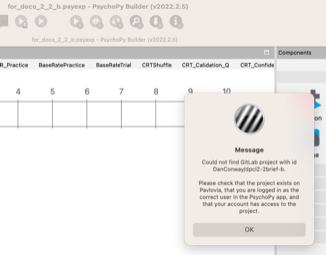Ok. I have had endless more trouble with this. A long, widly frustrating story follows below.
Prolific Project sync/uploading Bug(s).
I am trying to upload a project to Pavlovia. Note this project was previously uploaded and ran fine. I have since deleted the previous versions from Pavlovia using the ‘Dashboard’ interface. Now trying to upload this again. I have tried this a bunch of times now so the starting state for below includes a version seemingly uploaded.
Current version of project on Pavlovia (note caps):

When I use the ‘cog’ icon within Psychopy for project properties (note caps):

Project name and folder structure locally (note caps):

BUT…
When I use the ‘I’ button on the left hand side of builder. I get the message:

Why is this lower case? And this suggests that this particular function (whatever it’s doing) is case sensitive.
I now attempt to create a project (note lower case):

And then I get this message:

Which suggests that THIS particular process (whatever it is) is NOT case sensitive!
ARGH!!!
So where do I set the project name? In the cog wheel dialog box? In the ‘i’ (view details of this project) dialog box? In the experiment filename? When pressing ‘Sync’ for the first time? It would appear that all these things can be totally different and it is impossible to know which is correct or which is actually used for creating the Pavlovia file.
This part of the process is a total mess.
Can we please have a single source of truth for what the project is called and make it either case sensitive or NOT – and then tell people what the rules are around creating project names (as in explicit in the UI) and also a single way of syncing and uploading projects?
ALSO – somehow – at some point – psychopy appears to be converting underscores into dashes. I have lost track of exactly when and at what point this happens – but I have deleted all previous Pavlovia versions, and tried naming the project at all points: “dpcl2_2-brief-b” but then after using the ‘I’ button to create a pavlovia project, and then going to sync for the first time I get this error:

Note the dash and underscore difference. I swear I have been entirely consistent and this was somehow changed by psychopy or Pavlovia. This is a kafka-esque level of absurd.
Ah ok. So I have (again) set the project name in the cog icon menu to be ‘dpcl2_2-brief-b’ saved and closed the project. Deleted the previous attempts at uploads on Pavlovia. Open the project again, click the ‘I’ button and get this error:

Why on earth has that first underscore been changed to a dash?
WHERE IS it getting this from??? Some vestigial filename not properly deleted on Pavlovia? Is there some OTHER place in psychopy that stores the project name?
Ugh.
Ok. So I close Psychopy, delete previous projects with any related names from Pavlovia, then copy the entire local folder structure and rename the root.

I rename the PsychoPy Project to something completely new: ‘for_doco_2_2_b’, open the project, and click the cog wheel icon. I see that it has retained the previous project name. Ok. That’s fine and kind of expected. So I now change this project name to the same as the project name: ‘for_doco_2_2_b’. Click ‘Save’. I now click on the ‘Sync with Web project’ button and Psychopy opens the following dialog box suggesting that it is trying to upload this to an already existing project? What? What project has it found that it is trying to update? Based on what filename?

Ah. Ok. This is interesting. I cancelled out of the above – and instead used the ‘i’ button and immediately get this:

So it’s clear that somehow – SOMEWHERE – an old project name is being retained. Note this is after copying the entire local folder structure to a new location, renaming the Psychopy project, opening it, changing the name in the ‘cog icon’ dialoge box, and then saving the project. So WHERE is this old filename being stored / retained? Coz I suspect THIS is the cause of much of these problems.
And how? – oh HOW??? … do I blow this away and upload this new project?
@wakecarter













